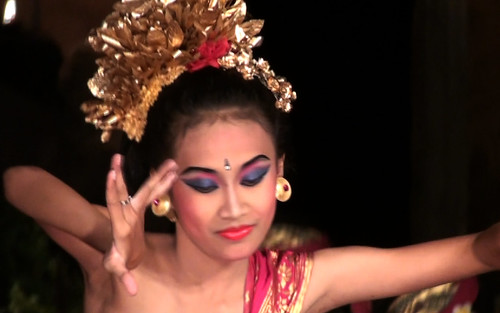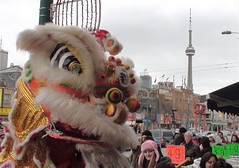A presentation dance, a welcoming dance, an offering dance... All of this can be a Balinese Gabor Dance.
Covarrubias didn't mention it in his book Island of Bali, and it seems that the dance was added to commercial performances, festivities and rituals after Covarrubias' presence in the island. Today it is usually performed by 6 young women at the beginning of any spectacle of Balinese dances for tourists (as it was my case the 20th of July 2009 at Ubud Royal Palace Stage), and it is continually used as a offering ritual dance in temples festivities.
The performance at Ubud Royal Palace Stage, presented by Sadha Budaya Troupe, had 9 different dances, with Legong as main dance (that night the production was named "Legong Dance"), and the Gabor dance was the first performed.
You should be aware that Balinese Dance's hands and eyes movement and postures you will see in the next photographs and videos don't "speak a language", as a Balinese writer says:
"Balinese hand gestures movements are not storytelling movements as in East Indian dance; rather they embellish the expression of the body." (1)
Hand gestures also can emphasize emotions, and postures of the body come from basic aesthetic principles of body movement and work for increasing its image projection on the stage. In this sense, Balinese dance is similar to our Ballet, with the exception that Balinese Performing Arts are almost always linked to religious ceremonies.
What is important is the special quality of the performer which can transport the audience to a different sphere, the Balinese term known as taksu or spiritual charisma. We'll keep talking about these topics and more, especially with our post of Legong Dance and the postures Covarrubias drew about its choreographies. (2)
Slideshow of Gabor Dance Performance at Ubud Royal Palace (2009)
This is what the program said about our first dance:
"Gabor / Welcome Dance
Panyembrahma is the presentation of an offering in the form of a ritual dance. The dance symbolizes the joyful reception of the Gods who attend a temple festival. Recently, Panyembrahma has been used to open the Legong Dance. It is performed by a group of young girls making identical movements. Toward the end of the dance the dancers make praying gestures and throw flowers to the audience as a welcome and a blessing."
It is a 10-minute choreography, so you can enjoy the video in one sitting in front of the screen.
Gabor dance performance at Ubud Royal Place (2009)
(1) Wayang Dibia and Rucina Ballinger. Balinese Dance, Drama and Music. Periplus Editions. Singapore, 2004.
(2) Miguel Covarrubias. Island of Bali. Periplus Classics. Periplus Editions. Singapore, 2007.
























